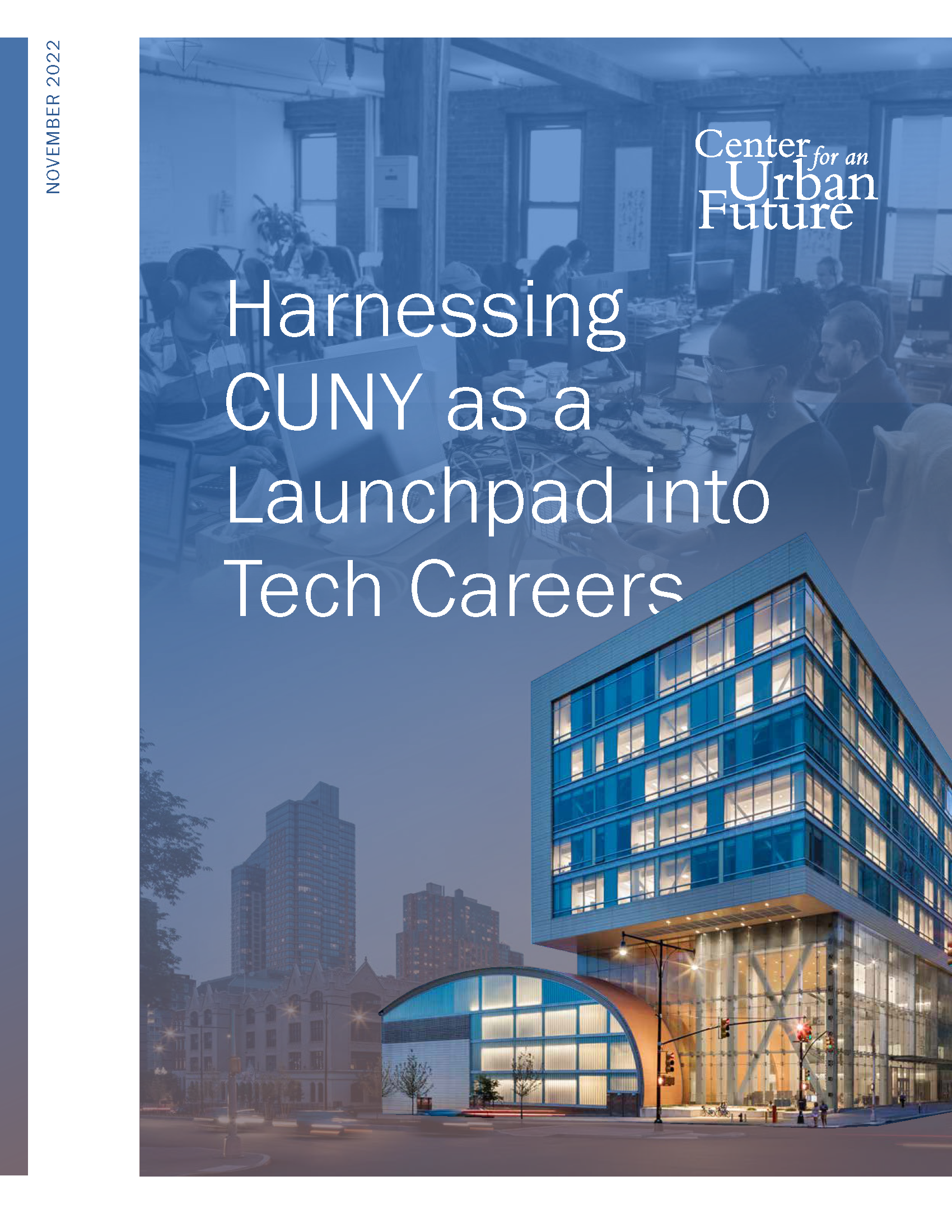Strengthening the Tech Sector as NYC’s New Jobs Engine
Help NYC continue to attract and retain talent by prioritizing investments in transit, parks, safety, and culture. Nothing has been as crucial to New York’s remarkable rise as a tech hub in recent decades than the city’s ability to attract and retain highly educated, creative, and entrepreneurial people. Simply put, tech companies big and small have chosen to locate and grow in New York, despite the nation’s highest costs of doing business, because of the city’s unparalleled pool of tech talent. Similarly, nothing would be more harmful to New York’s future growth prospects in tech than losing the city’s steady pipeline of talented tech workers. The most important thing city leaders can do to continue attracting and retain this workforce is by making investments that keep New York eminently livable, vibrant, safe, and easy to get around. This means boosting subway service, expanding and improving parks and open spaces, growing the city’s bike infrastructure, ensuring cultural vibrancy, and keeping the city’s streets safe and clean.
Create a plan to double employment in the city's tech sector by 2030. No other part of New York City’s economy has as much potential to add well-paying jobs in the years ahead, but it’s not a given that all this growth will occur. The Adams administration should develop a long-term strategy to ensure that New York realizes this considerable potential. Although city government isn’t going to double the size of New York’s tech sector, the wrong economic development, regulatory, and legal policies could cause the city to miss out on the sector’s extraordinary potential for future job growth.
Make the tech sector a central pillar of NYC's economic development strategy. The city’s economic development policies should be recalibrated to reflect the fact that the tech sector has become the leading driver of New York’s economic growth. Although tech has long been part of the city’s economic development policies, it’s time to elevate the sector’s role in those efforts.
Create a team at NYCEDC focused on helping NYC capture significant market share in several emerging tech sub-industries. New York has the potential to become a national or global leader in several emerging tech sub-fields, from blockchain and women’s and family tech to augmented reality and wellness. NYCEDC should create new staff resources to nurture and support these and other fields within the broader tech sector that have considerable potential for future job growth. This might be modeled after the “industry desk” system that NYCEDC used in prior years, in which dedicated staff were assigned to a sector—including life sciences, finance, media, and fashion—and charged with building relationships with industry leaders, understanding key challenges and opportunities facing the sector, and developing specially tailored programs and initiatives to support the sector. Under a new model, NYCEDC might assign staff to several different tech sub-industries, each of which faces unique challenges and opportunities.
Position New York to become an unmatched place for remote and hybrid work. While companies across the economy are adopting elements of remote and hybrid work, the uptake rate has been considerably higher in the tech sector. The fact that so many tech employees are opting to work from their homes doesn’t necessarily mean that New York will lose out, but it could spell problems over the long term if a growing share of New York’s tech employees decide to move elsewhere. New York City should get ahead of this trend, and make a series of infrastructure investments and policy decisions that enable New York to become the best place in the nation for remote and hybrid work. This might include investing in new pocket parks and open spaces in residential neighborhoods to make working from home in New York an even more attractive experience, and streamlining rules that make it easier for property owners in commercial strips outside of Manhattan to convert first or second-floor retail spaces into hubs for communal office work. It could also involve working with real estate leaders to ensure the development of new spaces in the city’s central business districts that aren’t offices but rather places that enable companies and workers to meet and build “connective fiber,” as urbanist Richard Florida has suggested.
Make NYC a test bed for new technologies. Nearly 40 percent of the companies operating at Newlab today relocated from outside of New York State. According to Newlab CEO Shaun Stewart, many of them opted to build their business here specifically because the Brooklyn Navy Yard is one of the only places in New York where early-stage companies can test their technology. Nearly everywhere else across the five boroughs, however, city regulations and rules make it incredibly difficult to launch the type of pilots that occur regularly in the Navy Yard—from testing pipe inspection devices under the buildings to piloting amphibious drones in the East River. City officials should change this and work with Business Improvement Districts (BIDs) and other community stakeholders to designate specific neighborhoods as spaces where startups can safely pilot urban tech like micromobility and autonomous vehicles, agriculture and food tech, and even certain types of manufacturing or quantum computing. The Downtown Brooklyn Partnership’s Living Lab initiative can serve as a model. Doing so would make New York attractive to entrepreneurs in the city and around the globe who are building the fast-growing companies of tomorrow.
Make it easier for startups to win city technology contracts. New York is the world’s second leading startup tech hub, but the city’s own procurement policies make it extremely difficult for any of the city’s small and mid-sized tech startups to compete for technology contracts. City officials should change this, re-evaluating its RFP system and eliminating barriers for small, local firms to win city contracts. Doing so would create powerful new growth opportunities for city startups, and potentially improve the effectiveness and efficiency of city government.
Step up efforts to attract international tech companies to NYC. It’s crucial that New York nurture the entrepreneurs and founders that are already here in New York, but the city can augment this job growth by becoming even more of a magnet for innovators to set up shop here. Although several dozens of tech companies from around the globe have either relocated to New York or established their American office here, many believe there is significant untapped potential. A concerted effort from NYCEDC could make a difference.
Launch a bold new city effort to expand access to tech jobs. While the tech sector has become the city’s most reliable source of new well-paying jobs, far too few New Yorkers of color have been able to access these jobs. To help change this, Mayor Adams should launch a bold, long-term plan to expand and improve the tech skills-building ecosystem, backed up by significant new public investment. This should include both an expansion of tech-focused training programs for adults and K-12 computing education. More specifically, we recommend prioritizing the following actions.
- Scale up the city's most effective tech training programs. While the city is home to exemplary career training organizations, too many of them serve only a few dozen or a few hundred New Yorkers each year. The Adams administration should provide new funding to expand these best-in-class tech training programs. This might include launching a “Race to the Top”-style competitive grant program that allows city officials to provide the most competitive applicants with new city funding that is separate from the city’s current pool of workforce dollars, which largely comes from the federal government and is highly restrictive in how it is used.
- Create new bridge programs, which provide crucial on-ramps to effective tech training programs. Currently, tens of thousands of New Yorkers struggle to gain admittance to the best tech training programs because of gaps in literacy, math skills and digital fluency—including the more than 1 million adults without a high school diploma. Bridge programs help the most economically vulnerable New Yorkers to get on the path to tech careers.
- Establish hundreds of new tech apprenticeships. Apprenticeships are a proven model for helping people without college credentials launch into the middle class, but the city is home to fewer than 100 apprenticeships in tech companies today. The Adams administration should with tech employers, CUNY, and nonprofit training providers to launch dozens of new tech apprenticeships—building on tech apprenticeships and “apprenticeship-like” models in the tech sector that are already working.
- Harness the City University of New York as a launchpad into tech careers. CUNY is well-positioned to help thousands more New Yorkers of color to access careers in the tech sector. But new city investment is needed to enable CUNY’s continuing-education programs to hire industry professionals, expand career services, cultivate industry partners, upgrade technology and learning labs, and boost counseling and wraparound supports.
- Build on the success of NYC's Computer Science For All initiative. Since its launch in 2015, the city’s CS4All initiative has embedded computer science education in more than 825 public schools. Mayor Adams should champion the program’s expansion to reach every public school student by 2025 and ensure that Department of Education (DOE) has the institutional support and accountability to keep on pace.
- Expand computing education in grades K-5. Early exposure to foundational computing education can help close achievement gaps for low-income students and shape early attitudes toward technology careers, but current offerings are extremely limited. The Adams administration should launch a vision for universal computing education.
- Invest in teacher training in computing education. For both K–12 schools and tech skills-building organizations focused on serving working adults, finding and developing skilled instructors poses a growing challenge. The city should invest in professional development and pre-service training in computing education, building on a promising pilot program at CUNY. That way, every teacher can gain the tools needed to integrate computational thinking into their classrooms.








